 Last additions - MIE 三重県 Last additions - MIE 三重県 |

Inside the Iga-ryu Ninja HouseApr 17, 2009
|
|

Entrance to the basement.Apr 17, 2009
|
|

Once a group gets large enough, they take you all in and a female ninja guide explains the house's ninja trickery. Admission charged. Recommended is the set of tickets that admit you to the ninja house, castle, and Danjiri Museum.Apr 17, 2009
|
|

There she goes.Apr 17, 2009
|
|

Now a shelf. It leads to the attic.Apr 17, 2009
|
|

Iga-ryu Ninja House is in Ueno Park which includes Iga-Ueno Castle nearby.Apr 17, 2009
|
|

Iga-ryu Ninja House garden. They take you in groups, so you may have to wait a while before you can go in.Apr 17, 2009
|
|

Ueno-shi Station has ninja dolls to greet you.Apr 17, 2009
|
|

The first demo is this swinging wall.Apr 17, 2009
|
|

An altar in the Iga-ryu Ninja House.Apr 17, 2009
|
|

Lets you escape to the next room instantly, or climb up or down the ladder on the right wall.Apr 17, 2009
|
|

One of the tallest castle walls in Japan.Apr 17, 2009
|
|

Apr 17, 2009
|
|

Apr 17, 2009
|
|

Park area above the castle wall.Apr 17, 2009
|
|

Apr 17, 2009
|
|

You could jump off into the moat below. No fences, so watch your kids.Apr 17, 2009
|
|

View from atop Iga-Ueno Castle.Apr 17, 2009
|
|

Edge of castle wall.Apr 17, 2009
|
|

View from atop Iga-Ueno Castle, looking toward Ueno-shi Station.Apr 17, 2009
|
|

Apr 17, 2009
|
|

Samurai armorApr 17, 2009
|
|

Inside the castle tower is the Iga Museum of Culture and Industry. This is the first floor.Apr 17, 2009
|
|

Bust of Kawasaki Katsu.Apr 17, 2009
|
|

Apr 17, 2009
|
|

Apr 17, 2009
|
|

Apr 17, 2009
|
|

Apr 17, 2009
|
|

Apr 17, 2009
|
|

Apr 17, 2009
|
|

Todo Takatora was originally from Omi or neighboring Shiga Prefecture.Apr 17, 2009
|
|

Todo Takatora's helmetApr 17, 2009
|
|

Apr 17, 2009
|
|

Top floorApr 17, 2009
|
|

Iga-Ueno Castle's donjon or tenshu tower was reconstructed in 1935 by Kawasaki Katsu, a local politician, using his own funds.Apr 17, 2009
|
|
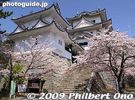
Apr 17, 2009
|
|

In 1980, Ueno Castle served as a backdrop for Kurosawa Akira's movie, Kagemusha.Apr 17, 2009
|
|

Apr 17, 2009
|
|

Apr 17, 2009
|
|

Iga-Ueno Castle and cherry blossoms, Mie Prefecture. During the Meiji Restoration, Ueno Castle's structures were dismantled as with many other castles.Apr 17, 2009
|
|

Apr 17, 2009
|
|

Apr 17, 2009
|
|

Iga-Ueno Castle and cherry blossoms, Mie Prefecture.Apr 17, 2009
|
|

Apr 17, 2009
|
|

Iga-Ueno Castle and cherry blossoms, Mie Prefecture.Apr 17, 2009
|
|

Iga-Ueno Castle and cherry blossoms, Mie Prefecture.Apr 17, 2009
|
|

In 1611, Todo Takatora took over Ueno Castle. Iga-Ueno Castle is also a major cherry blossom spot in early April.Apr 17, 2009
|
|

Iga-Ueno Castle is one of three major tourist attractions in the city of Iga. It is a short walk from Ueno-shi Station on the Kintetsu Iga Line.Apr 17, 2009
|
|

Stone marker for Ueno Castle located in Ueno Park. Officially called Ueno Castle and nicknamed Hakuho Castle or Iga-Ueno Castle. Noted for cherry blossoms in April and the highest castle walls in Japan.Apr 17, 2009
|
|

Iga-Ueno Castle was first built by Takigawa Katsutoshi, a vassal of Kitabatake Nobuaki (Oda Nobuo, Nobunaga's second son). In 1585, Tsutsui Sadatsugu took over. initiated construction of Iga Ueno Castle in 1585. He was followed by Tsutsui SadatsuguApr 17, 2009
|
|

They are still excavating a few areas of the castle for historical remains. I visited in April 2009.Apr 17, 2009
|
|

Making sure that the rope is aligned and positioned correctly.Apr 23, 2007
|
|

The rope installers return to shore.Apr 23, 2007
|
|
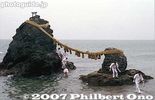
The job is finished.Apr 23, 2007
|
|
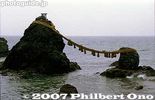
Wedded Rocks with a new rope. Japan has numerous other Wedded Rocks and stones, but this is by far the most famous.Apr 23, 2007
|
|
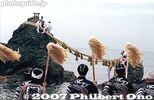
Apr 23, 2007
|
|
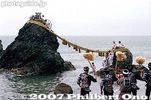
Apr 23, 2007
|
|
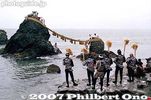
Apr 23, 2007
|
|
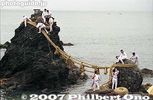
Replacing the rope for the Wedded Rocks, Mie Pref.Apr 23, 2007
|
|

Pieces of the old rope. Anyone could take home the pieces of old sacred rope if they wanted.Apr 23, 2007
|
|

Apr 23, 2007
|
|

Five ropes are being positioned and made taut.Apr 23, 2007
|
|

All the while, the cheering section chants and wave streamers.Apr 23, 2007
|
|
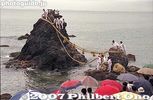
Apr 23, 2007
|
|
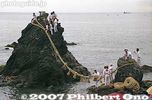
Apr 23, 2007
|
|

The second rope is installed.Apr 23, 2007
|
|

One by one, the men carefully positioned the new sacred ropes on the two Rocks. All the while, young children and young men are chanting on the shore.Apr 23, 2007
|
|
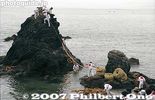
The new ropes are strung across the two rocks. A small rope tied to the end of the large rope is used to pull the large rope up the rock.Apr 23, 2007
|
|

The first rope is wound around both rocks.Apr 23, 2007
|
|
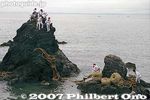
The old rope is taken away.Apr 23, 2007
|
|

Apr 23, 2007
|
|
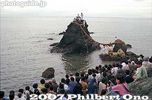
The ceremony attracts a large crowd.Apr 23, 2007
|
|

The ropes are now completely cut, breaking the bond between the two rocks.Apr 23, 2007
|
|

The shimenawa rope actually consists of five smaller ropes. They cut the ropes one by one.Apr 23, 2007
|
|
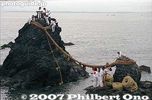
The men begin to cut off the old rope. Those sharp sickles soon made short work of the old sacred ropes which were brought ashore in small pieces.Apr 23, 2007
|
|
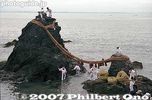
5月5日、9月5日と12月下旬には夫婦岩の大注連縄の張り替え神事が行われる。これらの写真は5月5日に撮影された。Apr 23, 2007
|
|
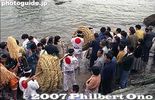
Men carry spanking-new shimenawa ropes to the rocks.Apr 23, 2007
|
|
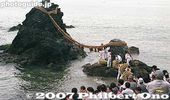
The Wedded Rocks are actually a type of torii gate for worshipping the Okitama Sacred Stone in the ocean.Apr 23, 2007
|
|

The torii on the larger rock is quite small. The sacred rope is replaced three times a year on May 5, September 5, and at the end of December.Apr 23, 2007
|
|
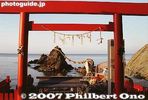
Futami Okitama Shrine does not have a main hall (Honden) like most other shrines. It worships the Okitama Sacred Stone in the ocean beyond the Wedded Rocks. 二見興玉神社Apr 23, 2007
|
|

Lantern and sunset at Futami Okitama ShrineApr 23, 2007
|
|

The shimenawa rope bonding the Wedded Rocks is replaced three times a year. May 5, when these photos were taken, is one of the days when they replace the rope. First, they gathered at the shrine at 10 am for a 30-min. prayer ceremony.Apr 23, 2007
|
|

Sunset at Futami Okitama Shrine. In the old days when traveling was a hazardous undertaking in Japan, pilgrims who traveled to worship at the Ise Grand Shrines prayed here for a safe return home.Apr 23, 2007
|
|

The frog is Sarutahiko's messenger. Frog is called "kaeru" in Japanese, which is a homonym for the another word meaning "return home." If you travel a lot, pray here for a safe return. 夫婦岩Apr 23, 2007
|
|
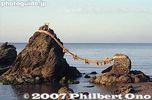
Meoto-Iwa Wedded Rocks off the coast of Futami-cho, Ise city, Mie Prefecture. 夫婦岩Apr 23, 2007
|
|
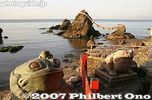
The shrine is dedicated to Sarutahiko and Ukano-mitama. Sarutahiko is a god which serves as a pathfinder guide. Deities for land/sea transportation safety. 二見�Apr 23, 2007
|
|

The Wedded Rocks are part of Futami Okitama Shrine known for frog sculptures. 二見興玉神社Apr 23, 2007
|
|

Nyutoku-mon GateJul 24, 2005
|
|
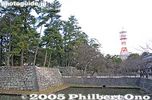
MoatJul 24, 2005
|
|

Garden in NishinomaruJul 24, 2005
|
|

Foundation of the castle towerThe 5-story castle tower was destroyed in 1600 during the Battle of Sekigahara. It was never rebuilt.Jul 24, 2005
|
|

Foundation of the castle tower (side view)Jul 24, 2005
|
|

Foundation of the castle tower (rear)Jul 24, 2005
|
|

Stone wall in the HonmaruJul 24, 2005
|
|

Tsu Castle, Ushitora turretJul 24, 2005
|
|

Park fountain in the castle groundsJul 24, 2005
|
|

Inner stone wallJul 24, 2005
|
|

Statue of Lord Takatora Todo, who became the 11th lord of the castle in 1608. He is revered for revamping the castle and developing the castle town of Tsu. He was originally from Inugami, Shiga Pref. This statue was built in 1998.Jul 24, 2005
|
|
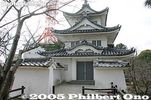
Ushitora turret entrance (not open)Jul 24, 2005
|
|

MoatJul 24, 2005
|
|

Ushitora turret and stone wallJul 24, 2005
|
|

MoatJul 24, 2005
|
|

Three-story Ushitora turret, reconstructed in 1958.This is the only significant building remaining of the castle.Jul 24, 2005
|
|

Ushitora turretJul 24, 2005
|
|

Castle wallThe stone wall is long, and the entrance to the castle grounds is on the far end, in front of the three-story Ushitora turret.Jul 24, 2005
|
|

Castle wall facing the streetWhen you walk to Tsu Castle from the bus stop, this is what you first see. It is obviously a flatland-type castle. Tsu Castle was first built in 1580 by Oda Nobukane, the younger brother of warlord Oda Nobunaga.Jul 24, 2005
|
|
|
|
| 1114 files on 5 page(s) |
 |
 |
5 |
|